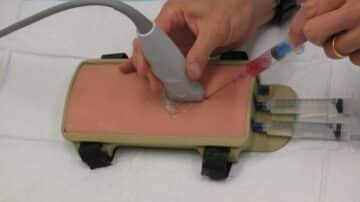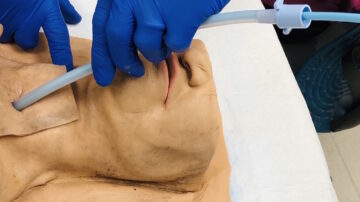Ascites is the accumulation of free fluid in the peritoneal cavity and can occur as a complication of a scarred liver, otherwise known as cirrhosis. While ascites is treated according to its underlying root cause, refractory ascites poses a bigger…
Read MoreIf a patient is unconscious, unable to swallow, or oral medications are slow to take effect, it can be difficult to administer medication. An intravenous (IV) injection or infusion is a commonly used solution in such cases. Through the IV…
Read MoreIf a patient’s airway is compromised during a life-threatening situation, prompt and effective intervention is crucial. This includes front-of-neck access (FONA) emergency airway, or cricothyroidotomy. Also known as cricothyrotomy, it is a specialized procedure that creates emergency access to the…
Read MorePoint-of-care ultrasound (POCUS) is a revolutionary diagnostic method that helps enhance physical examination at the point of care, that is, the patient’s bedside. Clinicians can use this tool to quickly diagnose medical conditions and guide treatment or bedside procedures, including…
Read MoreAwake fiberoptic intubation can be an effective solution in securing a patient’s airway due to difficult airway and in cases where conventional intubation is not an option. A difficult airway refers to a clinical situation whereby a healthcare provider faces…
Read MoreUltrasound technology has revolutionized the medical industry and provided physicians with the ability to visualize internal tissue and organs in real time. Advancements and changing trends in medical technology have also seen smaller and more affordable ultrasound machines cropping up…
Read MoreMore Articles – Chest Tube, Emergency Procedures, FAST Exam, Featured, King Tube, Medical General, RUSH Exam
Injury causes over 150,000 deaths per year in the U.S. and over 5 million worldwide. Around 80% of these traumatic injuries are blunt, with incidences of fatality secondary to hypovolemic shock and intraperitoneal bleeds. Fatalities can be prevented if professionals…
Read MoreDelays to hospital inpatient admission in excess of five hours from arrival at an Emergency Department (ED) lead to a mortality rate of 8.71%. This increases by another 8% in cases where admission is delayed beyond six to eight hours. …
Read MoreFever can be a serious complication in infants aged three months or younger. Immediate medical intervention is necessary to treat the possible infection, although clinical evaluation can be quite a conundrum. This is because there’s no way of knowing what…
Read MorePOCUS stands for Point of Care Ultrasound. It refers to the use of portable ultrasound machines at a patient’s bedside or point of care to help diagnose and manage medical conditions. POCUS is often used in emergency and critical care…
Read MoreWhile vasopressors are typically administered through a central venous catheter (CVC), peripheral intravenous (PIV) administration is becoming more common in clinical practice. The safety of this administration method is now well-established and is a good alternative to CVC placement for…
Read MoreBrachial arterial catheterization is widely chosen for constant blood pressure and hemodynamic monitoring in critically ill patients. It provides real-time measurements of physiologic parameters with a very low incidence of associated risks or complications. In this article, we will revisit…
Read MoreFor procedures involving lumbar punctures , sonographically guided lumbar punctures (SGLPs) have a higher propensity of being chosen when dealing with obese patients. This is based on findings of a randomized controlled trial conducted in 2007. The main takeaway from…
Read MoreMore Articles – Arterial line, Cardiovascular diseases, Central line, Chest Tube, Emergency Procedures, Endotracheal Intubation, Events, FAST Exam, Intraosseous line, King Tube, Laryngeal Mask Airway, Lumbar Puncture, Mechanical Ventilation, Medical General, medical procedures, Needle Decompression, Paracentesis, Procedural Sedation, RUSH Exam, Thoracentesis, Ultrasound-Guided Peripheral IV
Physicians, physician associates (PAs), and nurse practitioners (NPs) need to be adept in a range of essential medical emergency procedures that they must perform in an inpatient settings. These bedside procedures are accomplished readily, but only if you have the…
Read MoreFor decades the mantra for procedural education in medicine has been “see one-do one-teach one”. Those of us who learned bedside procedures and point-of-care ultrasound by this model understand that this approach does not optimize safe and competent performance. At…
Read MoreCategories
- ACLS (1)
- Arterial line (33)
- Cardiovascular diseases (77)
- Central line (55)
- Chest Tube (39)
- Dermatology (4)
- Emergency Procedures (138)
- Endocrinology (6)
- Endotracheal Intubation (36)
- Events (24)
- FAST Exam (12)
- Featured (112)
- Featured Procedure (42)
- Gastrointestinal diseases (32)
- Ginecology (3)
- Glidescope Intubation (21)
- Hematology (33)
- Hospital Procedures (85)
- Infections (32)
- Intraosseous line (8)
- King Tube (27)
- Laryngeal Mask Airway (18)
- Lumbar Puncture (36)
- Mechanical Ventilation (34)
- Medical General (95)
- medical procedures (258)
- Needle Decompression (6)
- Nephrology (11)
- Neurological diseases (12)
- Oncology (4)
- Paracentesis (32)
- Pericardiocentesis (3)
- Procedural Sedation (19)
- Respiratory diseases (85)
- RUSH Exam (8)
- Thoracentesis (37)
- Traumatology (24)
- Travel (27)
- Ultrasound-Guided Peripheral IV (13)















